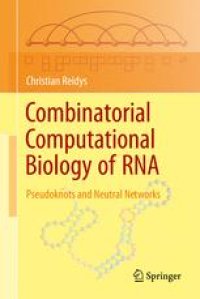
Ebook: Combinatorial Computational Biology of RNA: Pseudoknots and Neutral Networks
Author: Christian Reidys (auth.)
- Tags: Mathematical Biology in General, Combinatorics, Discrete Mathematics in Computer Science, Evolutionary Biology
- Year: 2011
- Publisher: Springer-Verlag New York
- Edition: 1
- Language: English
- pdf
In this monograph, new combinatorial and computational approaches in the study of RNA structures are presented which enhance both mathematics and computational biology. It begins with an introductory chapter, which motivates and sets the background of this research. In the following chapter, all the concepts are systematically developed. The reader will find * integration of more than forty research papers covering topics like, RSK-algorithm, reflection principle, singularity analysis and random graph theory * systematic presentation of the theory of pseudo-knotted RNA structures including their generating function, uniform generation as well as central and discrete limit theorems * computational biology of pseudo-knotted RNA structures, including dynamic programming paradigms and a new folding algorithm * analysis of neutral networks of pseudoknotted RNA structures and their random graph theory, including neutral paths, giant components and connectivity All algorithms presented in the book are implemented in C and are freely available through a link on springer.com. A proofs section at the end contains the necessary technicalities. This book will serve graduate students and researchers in the fields of discrete mathematics, mathematical and computational biology. It is suitable as a textbook for a graduate course in mathematical and computational biology.
In this monograph, new combinatorial and computational approaches in the study of RNA structures are presented which enhance both mathematics and computational biology. It begins with an introductory chapter, which motivates and sets the background of this research. In the following chapter, all the concepts are systematically developed. The reader will find * integration of more than forty research papers covering topics like, RSK-algorithm, reflection principle, singularity analysis and random graph theory * systematic presentation of the theory of pseudo-knotted RNA structures including their generating function, uniform generation as well as central and discrete limit theorems * computational biology of pseudo-knotted RNA structures, including dynamic programming paradigms and a new folding algorithm * analysis of neutral networks of pseudoknotted RNA structures and their random graph theory, including neutral paths, giant components and connectivity All algorithms presented in the book are implemented in C and are freely available through a link on springer.com. A proofs section at the end contains the necessary technicalities. This book will serve graduate students and researchers in the fields of discrete mathematics, mathematical and computational biology. It is suitable as a textbook for a graduate course in mathematical and computational biology.
In this monograph, new combinatorial and computational approaches in the study of RNA structures are presented which enhance both mathematics and computational biology. It begins with an introductory chapter, which motivates and sets the background of this research. In the following chapter, all the concepts are systematically developed. The reader will find * integration of more than forty research papers covering topics like, RSK-algorithm, reflection principle, singularity analysis and random graph theory * systematic presentation of the theory of pseudo-knotted RNA structures including their generating function, uniform generation as well as central and discrete limit theorems * computational biology of pseudo-knotted RNA structures, including dynamic programming paradigms and a new folding algorithm * analysis of neutral networks of pseudoknotted RNA structures and their random graph theory, including neutral paths, giant components and connectivity All algorithms presented in the book are implemented in C and are freely available through a link on springer.com. A proofs section at the end contains the necessary technicalities. This book will serve graduate students and researchers in the fields of discrete mathematics, mathematical and computational biology. It is suitable as a textbook for a graduate course in mathematical and computational biology.
Content:
Front Matter....Pages i-ix
Introduction....Pages 1-21
Basic concepts....Pages 23-65
Tangled diagrams....Pages 67-83
Combinatorial analysis....Pages 85-142
Probabilistic Analysis....Pages 143-186
Folding....Pages 187-212
Neutral networks....Pages 213-243
Back Matter....Pages 245-257
In this monograph, new combinatorial and computational approaches in the study of RNA structures are presented which enhance both mathematics and computational biology. It begins with an introductory chapter, which motivates and sets the background of this research. In the following chapter, all the concepts are systematically developed. The reader will find * integration of more than forty research papers covering topics like, RSK-algorithm, reflection principle, singularity analysis and random graph theory * systematic presentation of the theory of pseudo-knotted RNA structures including their generating function, uniform generation as well as central and discrete limit theorems * computational biology of pseudo-knotted RNA structures, including dynamic programming paradigms and a new folding algorithm * analysis of neutral networks of pseudoknotted RNA structures and their random graph theory, including neutral paths, giant components and connectivity All algorithms presented in the book are implemented in C and are freely available through a link on springer.com. A proofs section at the end contains the necessary technicalities. This book will serve graduate students and researchers in the fields of discrete mathematics, mathematical and computational biology. It is suitable as a textbook for a graduate course in mathematical and computational biology.
Content:
Front Matter....Pages i-ix
Introduction....Pages 1-21
Basic concepts....Pages 23-65
Tangled diagrams....Pages 67-83
Combinatorial analysis....Pages 85-142
Probabilistic Analysis....Pages 143-186
Folding....Pages 187-212
Neutral networks....Pages 213-243
Back Matter....Pages 245-257
....